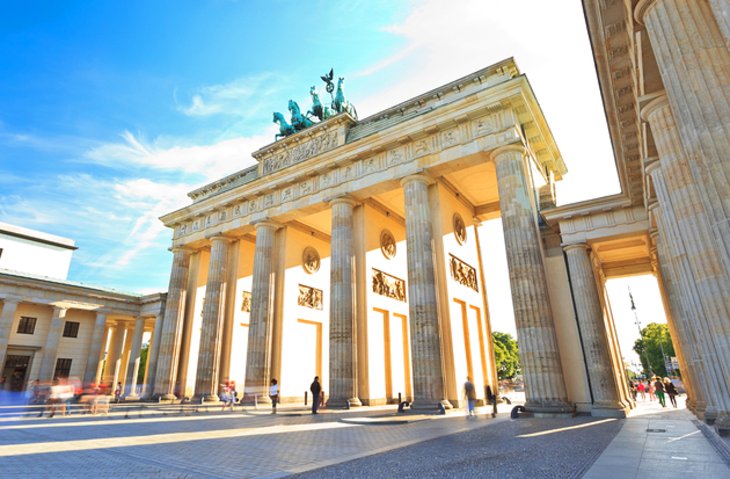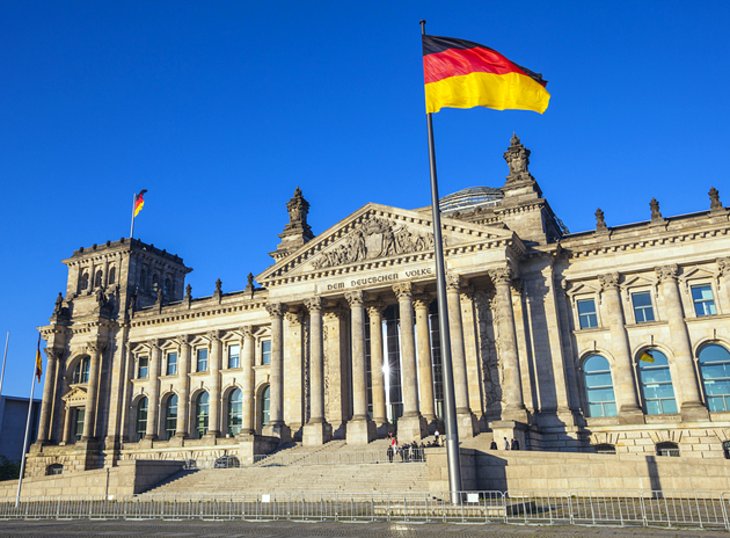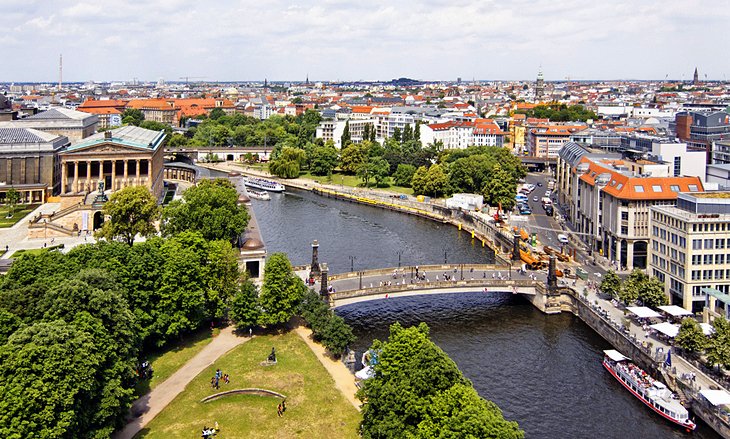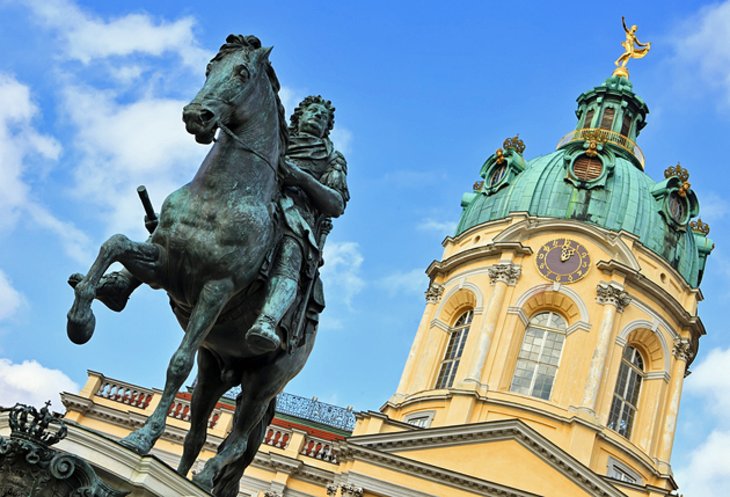Built
on sand on around the banks of the river Spree, Berlin has been one of Europe's
most influential economic, cultural and political centres - for better or worse
- since it's origins as a trading post in the 13th century. It was capital of
both the Prussian and the German Empire until World War I uprooted the Hohenzollern
dynasty, which had ruled since the 15th Century. After the War the Weimer
Republic was established and Berlin enjoyed a period of unprecedented
prosperity and creativity - known as the 'Golden Twenties'. In the 30s however
the German economy was collapsing and a accumulation of socio-political reasons
saw Hitler and the Nazi party seize power.

Berlin became the centre of one of the most infamous regimes in history, and remained so until 1945 when it was liberated by the Red Army. Unfortunately liberation was a painful process. The Russians, who has lost close to 30 million people in the conflict, exacted a heavy revenge on the citizens of Berlin. Men were killed or transported to slave labour camps, and women were systematically raped. Eventually in 1949 the Russians ceded several districts in Berlin to the Allies and the famous division between West and East Berlin - a microcosm of the division of the entirity of Germany - was formed. This division was made physical when the GDR (The German Democratic Republic, which was the Soviet run East German government) put up the famous Berlin Wall, allegedly to protect its citizens from 'the fascists', but in fact to prevent them from escaping into the more liberal and prosperous West. After the fall of the Wall, Berlin became the capital of unified Germany and a building boom began in the 1990s that included more than 30 major construction works in the east of the city. It has also become to be considered by many as the cultural capital of Central and Eastern Europe, excelling in every field but in particular those of dance/electronic music, contemporary art and dance, and classical and orchestral music. Berlin has three opera houses, over 150 theatres and playhouses, over 170 museums and collections and over 200 private galleries. Berlin also occupies a special place in Europe as an extremely liberal, socially progressive and tolerant city, placed in the heart of the continent, where East meets West.
1. The Brandenburg Gate

Berlin's most famous historic landmark is the Brandenburg Gate (Brandenburger Tor), once a symbol of a divided nation and now a symbol of unity and peace. This Neoclassical gate was commissioned by King Frederick Wilhelm II in 1788, and its design was inspired by the Propylaea in Athens' Acropolis. The sandstone monument is 26 meters tall, standing in the Mitte district's Pariser Platz, just a block from the Reichstag building. During the Cold War, its physical and symbolic position as a blocked gate along the Berlin Wall made it a frequent site for demonstrations by West Berliners, and it is famous for being the backdrop of US President Ronald Reagan's 1987 entreaty to Soviet leader Mikhail Gorbachev to tear down the wall. It was also the scene of a poignant gesture when German Chancellor Angela Merkel, Russia's Mikhail Gorbachev, and Poland's Lech Walesa walked through the gate in 1999 to commemorate the tearing down of the Berlin Wall 20 years earlier. Visiting the Brandenburg Gate at night is a special treat, and undoubtedly one of the top free things to do in Berlin. Brandenburg Gate, German Brandenburger Tor, the only remaining town gate of Berlin, Germany, standing at the western end of the avenue Unter den Linden. It has served as a symbol of both the division of Germany and the country’s reunification and is one of Berlin’s most-visited landmarks. The gate was commissioned by Frederick William II as an entrance to Unter den Linden, which led to the Prussian palace. It was built in 1788–91 by Carl G. Langhans after the model of the Propylaea in Athens. The sandstone structure is composed of 12 Doric columns that create five portals—the middle of which was originally reserved for royal use only—and stands approximately 66 feet (20 metres) high, 213 feet (65 metres) wide, and 36 feet (11 metres) deep. It is flanked by two small buildings, Haus Liebermann and Haus Sommer, which were built in the late 1990s by architect Josef Paul Kleihues to replace the pavilions that were destroyed during World War II. The gate is decorated with reliefs and sculptures designed by Gottfried Schadow, the majority of them based on the exploits of Heracles. In 1793 a quadriga statue depicting the goddess of victory bearing a symbol of peace was added. During the French occupation of Berlin (1806–08), Napoleon took the statue to Paris, where it remained until 1814. The gate was later used extensively in Nazi propaganda, and a parade was held there on Adolf Hitler’s ascent to power in 1933. The entire structure was heavily damaged during World War II, and in 1957–58 it was restored, with the quadriga recast from the original molds.
2. The Rebuilt Reichstag

The Reichstag (Reichstagsgebäude) was originally completed in 1894 where the Neo-Renaissance palace served as the home of the German Empire's Imperial Diet until it burned in 1933. It was not used again until after the reunification of Germany, at which point it underwent a 10-year reconstruction and finally became the home of the German Parliament in 1999. A highlight of this magnificent reconstruction is the replacement dome, the Kuppel, made of glass and offering superb views of the surrounding city, especially at night from the Rooftop Restaurant. Note that entry to the Dome and Terrace is ticketed, and due to demand, it's recommended that tickets be requested in advance (registration is available on the day, but expect a two- or three-hour wait). Free English language audio guides are available. The Reichstag building was designed by Paul Wallot and built southeast of the meander of the Spree. After ten years of construction work, the final stone was laid by Kaiser Wilhelm II on 5 December 1894. The six-story complex in the style of the Italian High Renaissance covers an area of about 13,290 square meters, and its four towers are 40 meters high. “Dem deutschen Volke” (To the German people) was inscribed above the main entrance in 1916. The events of 9 November 1918, when the Social Democrat and member of parliament Philipp Scheidemann proclaimed the republic from one of the windows of the building, focused political attention on the Reichstag. The democratic constitution of the first German republic, passed in Weimar on 11 August 1919 by the National Assembly, expanded the parliament’s authority considerably. The Reichstag building suffered heavy damage in bombing raids during World War II, and the fight to take the building continued until the very end. In 1955, the Bundestag decided to rebuild it, although without a dome, the original of which had been demolished in 1954 because it was structurally unsound. Renovation was carried out according to plans by Paul Baumgarten and not completed until 1972. The decorative figures that had been destroyed were not restored, and the façade was simplified. Despite the restrictions on use mandated by the Four-Power Agreement, parliamentary committees and groups met in the Reichstag building as often as possible. On 4 October 1990, the first parliament representing all of Germany and consisting of members of the Bundestag and former members of the GDR’s Volkskammer (People’s Chamber) met in the plenary chamber of the Reichstag building, followed two months later by the first sessions of the freely elected, all-German Bundestag beginning on 20 December 1990.
3. Museum Island

Sandwiched between the River Spree and the Kupfergraben in a 400-meter-long canal, Spree Island is better known as Museum Island (Museumsinsel), a UNESCO World Heritage Site. Here, you'll find many of the city's oldest and most important museums, including the Old Museum (Altes Museum), built in 1830 to house the Crown Jewels and other royal treasures. The New Museum (Neues Museum), destroyed during WWII, was rebuilt and opened again in 2009 as the home of extensive collections from the Egyptian Museum, the Papyrus Collection, and the Collection of Classical Antiquities. The Old National Gallery (Alte Nationalgalerie), opened in 1876, displays Neoclassical sculpture and paintings from 1815-1848, as well as Impressionist and early Modernist pieces. The Bode Museum houses a collection of Byzantine art, as well as a large sculpture collection spanning from medieval times to the late 1700s. The city's most popular museum, the Pergamon features a Museum of Islamic Art, the Ishtar Gate, and reconstructed historic buildings from the Middle East. The newest museum attraction, the Humboldt Forum opened here in 2019 and houses the Ethnological Museum of Berlin and the Museum of Asian Art. The history of Museum Island started with King Frederick William III who, in 1810, commissioned the creation of a public museum on Spree Island. In 1822 Karl Friedrich Schinkel drew up plans to develop the island, and a first museum building, the Royal Museum (now the Altes Museum) opened in 1830. The museum was built to allow the general public to view the royal art treasures of Prussia. It was the first such museum in the country. But the idea for a museum island wasn't devised until around 1841, when Friedrich August Stüler proposed the idea to create a cultural center on the island, which was lauded by all. The architect also designed the Neues Museum (New Museum), which opened in 1859 as the Royal Prussian Museum. The year 1876 saw the completion of the National Gallery (now the Old National Gallery). The Kaiser-Friedrich Museum (today the Bode Museum) was added in 1904 and the final museum, the Pergamon, was completed in 1930. Sadly, nearly seventy percent of the buildings were destroyed during World War II and, after the war, the collections were split up between East and West Berlin. After German reunification the collections were brought together again and a masterplan was drawn up designed to not only restore all five museums but also expand and modernize the museum complex as a whole. Work is underway for a new, modern entrance building, the James-Simon-Galerie, which will serve as the central hub for tickets and access to the museums. It is being built at the site of the former customs warehouse behind the Neues Museum.
4. Charlottenburg Palace and Park

Berlin's oldest and largest Prussian estate, the late 17th-century Charlottenburg Palace was for decades the primary residence of German royalty. Beautifully restored, this huge palace has extraordinary features, including a massive 50-meter-high central dome, opulent Baroque and Rococo décor throughout its expansive rooms, and a large garden that was inspired by the gardens at Versailles. A highlight of the property's tour program is a visit to the New Wing, with its State Apartments and fine Banqueting Halls. Built in 1746, it's here visitors get a glimpse of the splendor in which the Prussian Kings and Electors lived, from Frederick I's bedroom and study with their fine furnishings and paintings, to the State Dining Room and 42-meter-long Golden Gallery with its rich, gilded stucco. Over in the Old Palace is the Porcelain Cabinet, a room dedicated to a large historic porcelain collection and special exhibits, including the Crown Jewels and other royal items. Other highlights are the Palace Park dating from 1697 and home to the New Pavilion (Neue Pavilion), built in 1788 in the style of a Neapolitan villa, and the Belvedere Teahouse with its fine collection of Berlin porcelain. Be sure to visit the Mausoleum with its royal tombs, as well as the Grand Courtyard with its large statue of the Great Elector, Frederick William of Brandenburg. One of the top things to do in Berlin in winter is visit the Charlottenburg Palace Christmas Market, a spectacular display of more than 250 vendors and artisans exhibiting seasonal wares. Charlottenburg Palace (Schloss Charlottenburg in German) was extended in 1702, a year after Friedrich crowned himself. He had previously sent the royal architect to study architecture in Italy and France, especially the Château de Versailles. Sophie Charlotte died in 1705 and did not see the finished version of the Palace. In her memory, the King, renamed the mansion Charlottenburg. It had formerly been called Lietzenburg, after the district in which it was constructed. The British air force bombarded Berlin in 1943, destroying part of the Palace. Some of the building’s decoration could never be fully restored. Visitors will be accompanied by an audio guide throughout the visit of the Palace to learn about the past and most interesting stories of what happened in each room, transporting tourists to when the royal family enjoyed the residence. Some of the halls, ceilings and walls preserve the original furniture, decoration and frescoes. Unfortunately, the second floor of the Palace was not as lucky and was badly damaged during World War II, ruining the beautiful decorative elements. One of the most charming areas of Charlottenburg are the extensive and well cared for gardens designed in 1697 in a French Baroque style and reformed in an English romantic style in 1788. The enclosure was also badly hit during the air raids and were redeveloped in 2001, giving the Gardens a baroque style again. The gardens of Charlottenburg are a haven of peace in the city of Berlin, in which it is extremely enjoyable to stroll around, resting by its lake or visiting the Belvedere Tea House, dating from 1788.
Comments
Post a Comment